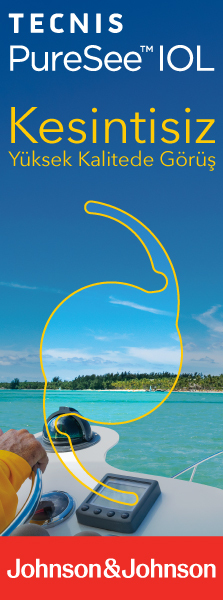TJ-CEO
2009 , Vol 4 , Num 1
Nd-YAG Capsulotomy; Effect on Intraocular Pressure According to Age
1Ümraniye Eğitim ve Araştırma Hastanesi Göz Kliniği, İstanbul, Uzm. Dr.2Çanakkale Onsekiz Mart Üniversitesi Göz Hastalıkları A.D., Çanakkale, Yrd. Doç. Dr.
3Ankara Mevkii Hastanesi, Ankara, Uzm. Dr. Purpose: To evaluate the effect of Nd-YAG laser capsulotomy on intraocular pressure (IOP).
Materials and Methods: Twenty four eyes of 22 patients with a mean age of 41.8±23.8 (range, 19-80) years who had no glaucoma history were included in the study. Etiology of cataracts were grouped as senile (10 cases), traumatic (8 cases) and juvenile (4 cases). No prophylactic treatment was carried out before or after Nd:YAG capsulotomy. IOPs were measured with applanation tonometer preoperatively and at 30th minute (m), 1st, 2nd, 4th hours(h), 1st and 7th days postoperatively. The amount of laser energy used in each procedure, change of preoperative and postoerative visual acuity were evaluated.
Results: Mean IOP was 12.9±3.0 mmHg preoperatively and 14.4±4.8 mm Hg at 30th m., 16.0±5.9 mmHg at 1st h., 15.2±6.1 mmHg at 2nd h., 13.1±3.6 mmHg at 4th h., 13.1±3.9 mmHg at 1st day, 13.1±3.0 mmHg at 7th day postoperatively. IOPs were measured as 28 and 30 mmHg at 1st h., 37 mm Hg at 2nd h. and 25 mmHg at 1st day in four of the cases who were required antiglaucomatous treatment postoperatively. Three of these cases were under 21 years old and the other was 71 years old; however, the relationship between age and increase in IOP was found not to be statistically significant (p>0.05). A significant increase in IOP was observed at 1st and 2nd hours postoperatively (p<0.05). The mean amount of laser energy used in the group of cases under 21 years old was 126.4±68.8 mj and 81±56.6 mj in the cases over 60 years old. This clear difference wasn’t found statistically significant (p>0.05). The mean visual acuity increased 4.8 lines in traumatic cases and 3.4 lines in senile cases (p>0.05) at 1st week postoperatively.
Conclusion: First two hours following Nd-YAG capsulotomy have a greater risk for IOP elevetion. Lack of tendency of mean IOP increase especially in older cases suggest that following up patients w/o any medication but using in case of necessity may be an alternative means. This study which is seen as preliminary results will be republished as soon as higher number of patients obtained for a clinical research. Keywords : Capsulotomy, cataract, glaucoma, intraocular pressure, Nd-YAG





